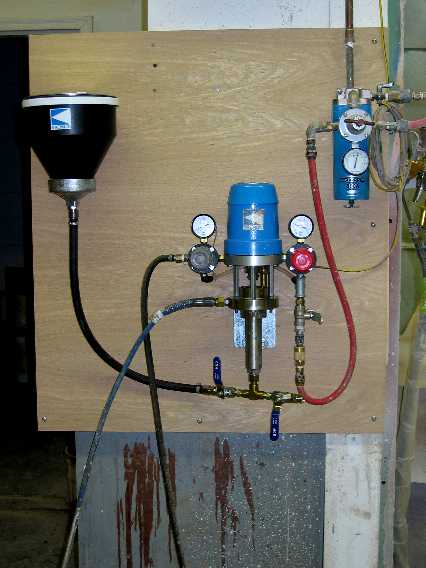Adjusting Pressure and Fan Patterns for HVLP Sprayguns
Finishers provide tips on setting up and adjusting pressure-pot-equipped HVLP sprayguns. December 31, 2005
Question
I am working with a pressure tank. I can not see to find the correct working point. Always, I have a shade in spraying lake (as if the fan has not set one above the previous).
I set the pressure for 0.5 atm and then with air line closed, I open/close the material layout to the point I want. I open the air until it atomizes the lacquer correctly, and then widen the fan to the point I want. After I set the air and material again to get a good fan and still working easy and slowly, I still get shades/light lines, although when the surface is wet, it seems it's a good, wet surface with none of these lines. Eventually I bought (made the owner buy) an HVLP 1 lit gun. It gives me better results, although I know the tank should do it better.
Can anyone please highlight the problems and solutions you've had with pressure tanks, and what things I should be aware of? And how can I solve these shade lines?
Forum Responses
(Finishing Forum)
Without knowing anything about your equipment or the product you're spraying... it sounds to me like your fan is set too wide.
There are no pre-set pressures for spraying. Your viscosity changes constantly due to temperature and mixing variables. I can give you some setup procedures but I need to know if you are using HVLP or conventional air spray. What size fluid nozzle are you using?
It sounds like your fan is set to wide. It may be a combination of variables. You need to be specific with the equipment you are using for more accurate answers.
A pressure pot setup is primarily a delivery system. It pumps the liquid from a pot to the point of atomization, the gun. The adjustments on the gun are more critical to the end result, providing you are getting enough liquid to atomize. Banding is not a problem I have run into with compressed or turbine HVLP systems. However, I have encountered them with airless systems. I would cut back on the pressure from the pot, close up your fan a little. Give it a try and see what happens.
From the original questioner:
I really would be giving more attention to my fan (the problem is it won't happen with basecoats, just with a topcoat). I use a two part coat, polyurethane outdoor coat. It's a really good Italian product. And I use its basecoat - a sandable polyurethane. Again, the pressure is enough to get enough material to the gun, HVLP gun. I do give it enough air to get atomized, and I know this because it is a bit above the point where you can see it turns from drops in the air to an atomized material. Maybe it is the angle I spray on (90 degrees). And I should be aware of the fan and its uniformity. The thing is it never happens to me with a hand gun (where the material is in a tank below the gun, 1 liter tank).
This is the way I teach customers to set up HVLP pressure pots. First shut off the atomizing air to the gun. Start with your fluid pressure regulator off. Slowly add pressure to the tank with the gun triggered and the needle adjustment in the full on position. Hold the gun parallel to the floor and adjust the pressure to yield a 6"-8" straight fluid stream before the stream falls off.
Then introduce your atomizing air to produce the smallest droplets at the lowest pressure. I usually spray a quick trigger at a piece of cardboard and look at the outside edges for droplet size. Another thing about HVLP is your gun should be no further than 8" from the substrate.
This sounds like a viscosity problem. Do you have a viscosity cup? Some retarder may help, too. When setting up the spray, turn off the air and set the fluid pressure so that you have a stream that shoots out to 3 ft (1 meter) with the fluid feed knob on the gun about 1 1/2 turns from fully shut. Turn on the air and make a test shot onto some cardboard on the floor. If you have an irregular spray pattern, adjust the fan, the air and/or the fluid flow until it's perfect. Is that what you were asking for?
From the original questioner:
Thanks - you are more than helpful.
